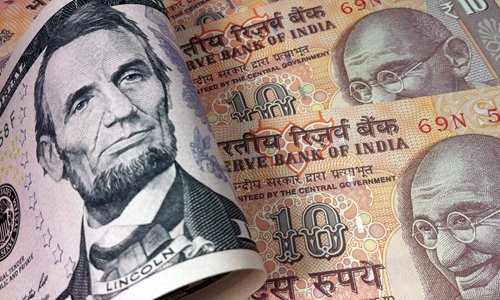HOME >> OPINION
Tariffs in glare as India-US ties wobble
By Mao Keji Source:Global Times Published: 2019/8/1 19:13:39

Photo: IC
Recently, India-US relations have encountered challenges. The economic tension spawned by the US termination of India's Generalized System of Preference (GSP) designation in June and following tit-for-tat tariff hikes from the Indian side reflects a fundamental lack of trust and rapport between the two countries.
To be fair, India-US bilateral trade and investment relations are on the whole healthy. Goods and services trade between the two grew at an average annual rate of 7.59 percent from 2008 to 2018, doubling in value from $68.4 billion to $142.1 billion, according to Press Trust of India. However, these constructive elements are not always on the same plane as economic relations.
Unlike China or Mexico, whose exports account for a dominant part of the trade deficit of the US, India, ranking the ninth-largest trading partner of the US in 2018, is a small fish. However, US President Donald Trump, who firmly believes that every penny counts, has frequently spoken of the disadvantage the US encounters when doing business with India, because India is a "very high-tariff nation."
As early as in April 2018, the US started reviewing India's eligibility as a beneficiary under the US GSP program. After a series of negotiating sessions between the US Trade Representative (USTR) and the Indian Ministry of Commerce and Industry (MOCI), USTR concluded that India failed to "provide the US with assurances that it will provide equitable and reasonable access to its markets in numerous sectors."
As a result, USTR advised the president to revoke India's beneficiary status, which Trump finally announced on May 31, 2019.
The loss of GSP beneficiary status may have serious implications for India. On the one hand, India was the largest beneficiary in 2018 in the program, enjoying as much as 25 percent of US imports under the GSP. On the other hand, Indian exports of GSP beneficiary products reached $15 billion from April 2018 to February 2019, accounting for almost one-third of India's total exports to the US. After the suspension of GSP, major Indian export items including gems, jewelry, electrical and non-electrical machinery, chemicals, auto components, iron and steel products will be subject to higher tariffs when entering the US market.
The suspension of GSP was bad timing for Indian Prime Minister Narendra Modi administration, which has determined to develop India's export sector as a major pillar for the goal of making India a $5 trillion economy by 2024. So, in retaliation, India announced a tariff hike on 29 US products.
It was against this backdrop of escalating economic tension that US Secretary of State Mike Pompeo first embarked on a two-day India trip on June 25 and then Modi met Trump on the sidelines of the G20 summit in Japan to address their differences. After that, MOCI and USTR met from July 11 to 12, but those trade talks ended without major progress. Right now, tough questions on agricultural commodities, e-commerce, steel and aluminum have been put off until MOCI officials' next scheduled visit to Washington in August.
However, the two sides are unlikely to strike a quick deal. While the Trump administration targets India's market and is preparing for, according to Indian Foreign Minister Subrahmanyam Jaishankar, "a larger game, a larger opening," the Indian side is concerned that such a scenario may dent the country's competitiveness and lead to a flurry of imports hurting India's dream of becoming a $5 trillion economy in five years.
In addition to the conflict between "America First" and "India First," institutional shortcomings from the two sides may also frustrate both countries in trade talks. For example, a recent report by the US-based think tank Atlantic Council insightfully observes that "USTR is generally empowered by the president and relevant Cabinet-level departments to negotiate market-opening outcomes, whereas MOCI is not similarly supported. This leaves MOCI undercut and cornered, even as it confronts expectations that it make bilateral problems go away."
India-US ties are for sure one of the most consequential relations of the world in the 21st century, and trade is vital in determining whether their overall relationship is constructive or adversarial.
While conflicts may significantly set back the relations when the need to cultivate trust and to achieve some confidence-building outcomes is urgent, with a broader strategic convergence in hope, they may also create new leverages and focus political capital to eventually hammer out some agreements.
The author is an observer on South Asian affairs. opinion@globaltimes.com.cn
Posted in: ASIAN REVIEW